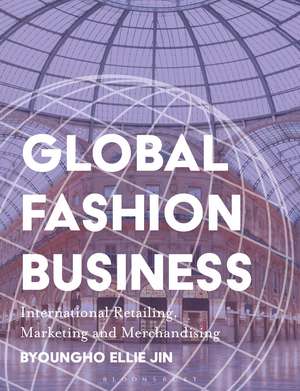Global Fashion Business: International Retailing, Marketing, and Merchandising
Autor Dr. Byoungho Ellie Jinen Limba Engleză Paperback – 7 aug 2024
Preț: 245.54 lei
Preț vechi: 277.98 lei
-12% Nou
Puncte Express: 368
Preț estimativ în valută:
46.98€ • 51.20$ • 39.59£
46.98€ • 51.20$ • 39.59£
Carte disponibilă
Livrare economică 02-16 aprilie
Livrare express 19-25 martie pentru 80.54 lei
Preluare comenzi: 021 569.72.76
Specificații
ISBN-13: 9781350180185
ISBN-10: 1350180181
Pagini: 272
Ilustrații: 50 bw illus
Dimensiuni: 189 x 246 x 17 mm
Greutate: 0.75 kg
Editura: Bloomsbury Publishing
Colecția Bloomsbury Visual Arts
Locul publicării:London, United Kingdom
ISBN-10: 1350180181
Pagini: 272
Ilustrații: 50 bw illus
Dimensiuni: 189 x 246 x 17 mm
Greutate: 0.75 kg
Editura: Bloomsbury Publishing
Colecția Bloomsbury Visual Arts
Locul publicării:London, United Kingdom
Caracteristici
PowerPoint slides outline a suggested course structure and class notes for instructors to follow. QR codes direct readers to supporting online examples
Notă biografică
Byoungho Ellie Jin is the Albert Myers Distinguished Professor in the Department of Textile and Apparel, Technology and Management at North Carolina State University, USA. Her contribution to the global fashion marketing and branding discipline can be found in more than 140 journal articles and numerous funded research projects. She is the co-author of Fashion Business (2002) as well as Brands Rule the World (2015), and co-editor of Fashion Brand Internationalization (2016), Fashion Branding and Communication (2017) and Process Innovation in the Global Fashion Industry (2019). Dr. Jin served as president of International Textile and Apparel Association (ITAA) in 2021.
Cuprins
Part I: An Overview1. Nature of Global Fashion BusinessThe characteristics of fashion businessThe status of fashion brand internationalizationFashion brand internationalization: Motivators, Enablers, and Benefits Trends that affect the scope and speed of fashion brand internationalization Case study 1.1. Beaucre's Timely Entry into China in 1999 Case study 1.2. Anta's ascent to the world's 9th largest sportswear companySummaryClass ActivitiesReferencesAppendix 1. Top 250 Global Retailers 2022Appendix 2. Global fashion industry: Size, growth, and potential by regionAppendix 3. Apparel and footwear market Sizes by region: 2016-2026 2. Global Fashion Marketing StrategyGlobal fashion marketing definedGlobal marketing strategy Inherent challenges associated with global fashion marketing Case study 2.1. Macy's Exit from ChinaSummaryClass ActivitiesReferences Part II: Global Environments Affecting Fashion Business3. Economic Environment of Global Markets: Why and How it MattersEconomic development level: Classification and General characteristics of each category Characteristics and challenges of retail markets by a country's economic development level Implications of economic environment on global fashion marketing Case study 3.1. An Overview of China: It will be a mistake to view China as one countryCase study 3.2. Strong Prospects of India's Apparel MarketSummaryClass ActivitiesReferences 4. Cultural Environment and its impact on global fashion businessDefining culture and cultural elementsHall's cultural dimensions and its implication on fashion businessHofstede's cultural dimensions and its implication on fashion businessOther cultural frameworksImplications of cultural environment on global fashion marketingCase study 4.1. Two Boycott cases: Muslims against Danish brands and Chinese against Dolce & GabbanaCase study 4.2. Why are second hand markets not thriving in China?SummaryClass ActivitiesReferencesAppendix 1. Dolce & Gabbana's advertisement accused of racism in ChinaAppendix 2. Dolce & Gabbana's apology 5. Legal and Regulatory Environment: Playing by the RulesGovernment regulation on retail sectorIntellectual property issues in the global fashion industryRed tape, bribery and corruption: Implications for global fashion companiesCase study 5.1. Ralph Lauren's Bribery in ArgentinaSummaryClass ActivitiesReferencesAppendix 1. Corruption Perceptions Index Part III: Assessing Global Market Opportunities6. Internationalization TheoriesInternationalization process modelOwnership-Location-Internalization (OLI) modelTransaction cost analysis frameworkNetwork modelCase study 6.1. Why Target's First Internationalization FailedSummaryClass ActivitiesReferences 7. Where to Enter: Entry Market Selection DecisionEntry market selection approaches: Systematic vs. Non-systematicHost country factors that affect fashion firms' entry market decisionFirm factors that affect entry market decisionCase study 7.1. Havaianas's Flip-flops: From a Commodity to a Premium ProductSummaryClass ActivitiesReferences 8. How to Enter: Entry Mode DecisionMarket-entry choicesFactors related to entry mode decisionsImplications for fashion companiesCase 8-1. Two Sides of Licensing: The Case of Burberry in JapanCase 8-2. Macy's Exit from a Joint Venture with China's Fung GroupSummaryClass ActivitiesReferences Part IV: Developing Global Marketing Strategies9. Brand Management for Global MarketsTypes and benefits of global brandsStrategic global brand management processConsumer culture positioning strategyCountry of origin and country image for global fashion brand managementCase 9-1. Tommy Hilfiger's different positioning across countriesSummaryClass ActivitiesReferences 10. Product Development for Global MarketsThe importance of offering products and services suitable for the global marketsDeveloping culturally appropriate productsProduct localization approaches for global marketsCase study 10.1. How Gentle Monster Achieved its Wild SuccessSummaryClass ActivitiesReferencesFurther reading 11. Pricing for Global MarketsTaxes and tariffs on imported goodsPrice escalation and how to minimize its effectApproaches to pricing for global marketsFactors that affect pricing decisionParallel imports and its implications for global fashion companiesImplications for global brand brandsCase study 11.1. Cross-border Shopping and Luxury FashionCase study 11.2. Chanel handbag pricingSummaryClass ActivitiesReferences 12. Retail and Distribution for the Global MarketsInternational distribution channel decisionInternational distribution channel configurationDigital distribution: Opportunities and Challenges in the global marketplacesChallenges in developing countries: Payment and Logistics challengesCase 12-1. WeChat and Mobile Shopping Channel in ChinaSummaryClass ActivitiesReferences 13. Communications and Advertising to Global ConsumersGlobal advertising: Standardization vs. AdaptationCultural implication of international advertisingRegulations and challenges related to advertising across countriesCase study 13.1. Gymshark's Impressive Rise: Social Media and Brand Community StrategiesSummaryClass ActivitiesReferencesFurther reading. Burberry ad in ChinaAppendix 1. Shiseido advertisement on InstagramAppendix 2. Puma's Run the Streets campaign: US vs. KoreaAppendix 3. Patagonia Houdini Jacket ad: Individualistic vs. Collectivistic cultureAppendix 4. Estee Lauder's advertisements: Masculine culture vs. Feminine cultureAppendix 5. Clarks advertisements: Saudi Arabia vs. KuwaitAppendix 6. Yves Saint Laurent's banned Ad in the U.K.Appendix 7. Miu Miu's banned advertisement in U.K.Appendix 8. Lancome's banned advertisement in the U.K.
Recenzii
A very comprehensive text, which makes a positive contribution to the subject knowledge of fashion business, offering a truly global viewpoint. From a teaching viewpoint, pedagogic features are excellent, providing opportunities for lecturers to draw upon the case studies and suggested class activities to engage students in quality discussions.
